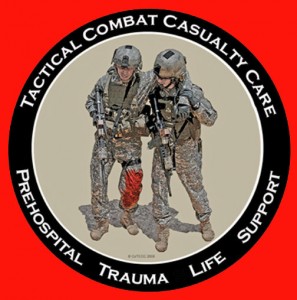Last week, I attended my department’s annual forty-hour In-Service training block. The final day had instruction to which I had not been exposed in many years of police work: an introduction to Tactical Combat Casualty Care.
What has always been in the trunk of the cop car? A first aid kit. What was it useful for? Not much really. Antiseptic, band-aids, and some Ibuprofen are far from helpful in a real live trauma emergency when rounds may be flying.
The concept of TCCC (Tee-Triple-Cee) began with a 1996 paper that was published in Military Medicine. U.S. Special Operations Command ran with the ideas and methods and slowly began implementing TCCC in its units. It is now standard training in all branches of the Armed Forces. The goals of TCCC are 1) treat the casualty, 2) prevent additional casualties, and 3) complete the mission.
Our baby steps into TCCC were taught by two of our fire-rescue department’s paramedics, both of whom happen to be long-standing SWAT medics for our Tactical Team. Since medical runs are the bread and butter of most fire departments these days, our medics have a tremendous amount of practical experience treating the injured.
The course of instruction was split into five hours of classroom and five hours of scenario-based training. I appreciated that the medics began with an overall look at diet and health for the officers, touching on such things as stress and heart disease. There was also a CPR and AED refresher.
TCCC has three stages: Care Under Fire, Tactical Field Care, and Combat Casualty Evacuation Care. As a police officer or deputy sheriff on the street, we need to be concerned with Care Under Fire. The latter two stages will be dealt with when medics arrive to provide more competent medical services.
That said, the Care Under Fire stage addresses mitigating the casualty’s injury while maintaining security in a hostile situation. Military studies suggest that there are three types of injury that lead to what are called “preventable combat deaths.” These are extremity hemorrhage, tension pneumothorax, and airway obstruction. Our class gave us basic instruction on field treatment in all three areas.
As cops, we all have to have some knowledge of first responder medicine. TCCC, even in our very dumbed-down version, goes past Academy training to give hands-on life saving techniques with available tools. This must, unfortunately, be kept at the level of the lowest common denominator, which is often your barely interested partner.
Nowadays, a police officer must master a bevy of skill sets from lawyer to soldier to counselor to politician, and maybe IT technician and daycare worker. At none of these things are most of us truly proficient. I have found that the KISS concept works best when teaching something new to a room full of cops.
The SWAT medics, who have had the dubious pleasure of hanging around with us for years, did a great job of staying on topic for a few BLS techniques we may have to employ. We performed basic assessments, put Combat Application Tourniquets on ourselves and each other, covered sucking chest wounds, and were taught some buddy carry methods.
For the scenario-based training, we responded to several mock calls where we had to safely enter a hot area with a critical incident in progress and manage the scene and perhaps a casualty.
It began with a single officer arriving at an officer down, moved to a pair of officers coming on scene at an officer assault, and ended with small groups of us handling a more complicated problem with multiple casualties and tactical clearing inside a residence.
While walking back to the staging area after one scenario, a medic threw you a tourniquet and said, “You’re shot in the arm.” Oh. After you had properly applied your tourniquet to the affected limb with one hand, he said, “Draw your gun.” Hmmm, coincidently, my dominant arm was now useless. Fortunately, we practice non-dominant-hand draws on the firing range.
The officers did not know the scenarios in advance and their performances were critiqued afterward not only by the SWAT medics, but by Tactical Team members and other department trainers. In that way, the students received feedback on their medical treatment and tactics.
I will admit that I hate scenario training, but this portion of the instruction was handled very well and did not disintegrate into some unrealistic paintball match with Simunitions. Kudos to the instructors.
Budget constraints being what they are, only our SWAT members are currently issued CAT tourniquets and QuikClot. I heard some moaning from the guys about not having the PD provide these to line officers. In my cruiser’s bailout vest, I have a SOF-T tourniquet and some QuikClot combat gauze, which I purchased myself.
The two cost me less than sixty bucks; under a hundred dollars buys a more complete kit. But what is that worth compared to saving someone’s life? Goodness knows some of the guys spend more than that on “cool looking” sunglasses to wear on duty.
For those interested in learning more about TCCC from a law enforcement perspective, I recommend reading A Police Officer’s Guide and Handbook to Tactical Casualty Care (Under Fire): First Aid and Self First Aid for Law Enforcement. It is written by a Florida sheriff’s deputy, who is retired from 21 years of service in the U.S. Army. (disclaimer: I have no monetary interest in this book or its retailer, nor do I know the deputy, it just seems to have a good bead on the topic.)
Our introductory course scratched the surface of TCCC concepts, but it better prepared us for a medical casualty in dangerous conditions. I think this is appropriate training at a time when lethal attacks on police officers have risen sharply.
Randall


